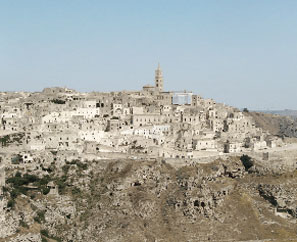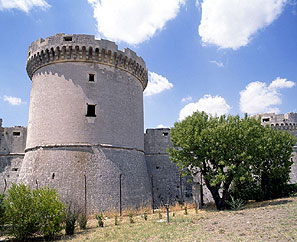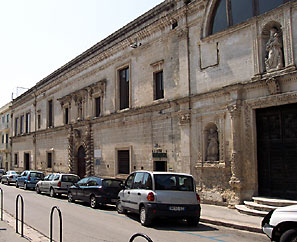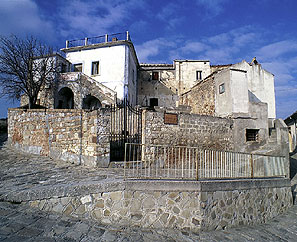|
 Matera is the town of the Sassi, the ancient quarters that, shrouded in archaic charm, are an example of an incomparable urban structure: Sassi and the facing Murgia Plateau are now inscribed on the World Heritage List on behalf of UNESCO, a patrimony belonging to all mankind. Town of one hundred and more rock-hewn churches, revealing Latin and Byzantine frescoes, inspired by the mysticism of solitary monks and embodied in religious art. Matera is the town of the Sassi, the ancient quarters that, shrouded in archaic charm, are an example of an incomparable urban structure: Sassi and the facing Murgia Plateau are now inscribed on the World Heritage List on behalf of UNESCO, a patrimony belonging to all mankind. Town of one hundred and more rock-hewn churches, revealing Latin and Byzantine frescoes, inspired by the mysticism of solitary monks and embodied in religious art.
Of equal cherm are the small towns and villages surrounding Matera, with their characteristic and lovely twon centres, whose ancient streets will amaze the passers-by, who cannot but perceive the efforts and the hardships of the people, and that will also reveal traditions, folk celebrations, religious feasts, the spontaneous hospitality and the inviting food. A totally enrapturing territory, from the splendour of its Jonian coasts with fine sandy shores and its original naturalistic environment to the charm of the ravines, monasteries and the "incandescent" gullies, all gerns that will enchant its visitors.
 Matera: (401 m. above sea level) still bears the unique signs of history and prehistory. Dating as far back as the period of the Punic Wars, Matera sheltered the fugitives of Metapontum and Heraclea. Thus, its name may derive from tha comnation of the first three letter of the names of the villages above-mentioned (Met - Era), even most learned men claim thet it could also derive from "Mata", wich means "heaps of rocks". Matera: (401 m. above sea level) still bears the unique signs of history and prehistory. Dating as far back as the period of the Punic Wars, Matera sheltered the fugitives of Metapontum and Heraclea. Thus, its name may derive from tha comnation of the first three letter of the names of the villages above-mentioned (Met - Era), even most learned men claim thet it could also derive from "Mata", wich means "heaps of rocks".
According to some people, Matera, that used to be part of Apulia, was probably founded in 251 b.C. by Metello (a Roman Consul) who called it Matheola. It is only in the 9th century that this theory was confirmed by some more reliable informations. Later on, after the succession of various rulers, the "Tramontano" came to reign by investiture on behalf of ferdinand of Aragon. On 1514 December, 29 during a popular uprising, Count Giovanni Carlo Tramontano was killed because of his cruelty towards the peasants.
Matera was the capital of the region from 1663 since 1806, when Joseph Bonaparte transferred this prestigious role to the town of Potenza
 Now Matera is the residence of the archbishop and boasts the important 13th century Cathedral as well as the churches of St. Domenico, St. Giovanni Battista, St. Francesco d'Assisi, St. Chiara, Purgatory, St. Francesco da Paola and many others, whose characteristic architecture represent the different ages and their fine workmanship. Now Matera is the residence of the archbishop and boasts the important 13th century Cathedral as well as the churches of St. Domenico, St. Giovanni Battista, St. Francesco d'Assisi, St. Chiara, Purgatory, St. Francesco da Paola and many others, whose characteristic architecture represent the different ages and their fine workmanship.
The particular characteristic of the land, its morphology and that of the Murgia Plateau of Matera encouraged, between the 8th and 13th centuries, the development of an intense monastic movement that found tha ancient cave.dwellings as the ideal habitat for monasteries and rock-hewn churches since they reproduced tha original pattern of those existing in their own countries. Throughout the countryside of Matera there are more than 130 rock-hewn churches, some of them are underground churches, whereas tha others are carved into the rock integrating with the outside constructions that witness the presence of latin and Greek-Byzantine monastic cultures in Matera, their meeting point throughout the centuries.
 The Cathedral stands on a rise overlooking the two valleys of the Sassi, that in ancient times was the site of the Church of St. Eustachio. It's an outstanding example of Romanesque-Apulian architecture; the pediments mounted on its altars originally belonged to the destroyed temples of Metaponto. The frescoes are from the school of Naples. The elaborate Stone Nativity, sculptured by the artistis Altobello Persio from Montescaglioso, is very interesting. The Cathedral stands on a rise overlooking the two valleys of the Sassi, that in ancient times was the site of the Church of St. Eustachio. It's an outstanding example of Romanesque-Apulian architecture; the pediments mounted on its altars originally belonged to the destroyed temples of Metaponto. The frescoes are from the school of Naples. The elaborate Stone Nativity, sculptured by the artistis Altobello Persio from Montescaglioso, is very interesting.
The construction of the Cathedral, commissioned by Archbishop Andrea started in 1230 and ended in 1270. The Cathedral of Matera has one neve and two aisles and represent the perfect blend of art and faith. The former representing tha best expression of man's skills; the lattaer as an engagement to defy the passing of time and the loss of its true religois signficance.
The National Museum Domenico Ridola is named after its founder, a doctor and archaeologist famous throughout Europe. He was born in Ferrandina. a small town in Basilicata and died in 1932. He founded the museum in 1910 and later he donated it to the Italian Governement. Dr. Ridola explored the subsoil of the area surrounding Matera, in particular the area of Timmari, discovering important archaeological treasures such as the prehisotric tools made of smooth stone, sarcophaguses with historiated crockery and lachrymatories, statues, primordial weapons, necklaces, coins etc. At present, the Museum is divided into large rooms where all the findings are displayed. Each of these rooms have been named after the sites where the findings were discovered.
Folklore
The Feast of the Visitation of the Virgin Mary and the Bruna's Feast: Pope Urbano VI, previously bishop of Matera, introduced the Feast of the Visitation of Virgin Mary on 2 July 1389. Parhaps, to recall this event, the people of Matera, decided to celebrate the "Bruna's Feast" in the same day, every year. This feast dates back to ancient times. It's an extraordinary feast with a broad programme including: The Procession of Shepherds which leaves the Cathedral at dawn, the costumed Cavalcade and the parade of the "Carro Trionfale" - "Triumphal Float", all being the main attraction of the feast. The Triumphal Float is a craftwork of papier-maché made by local artists. The feast reaches its climax when a large exultant crowd of people, among whom there are many foreigners, assault the Carro in order to destroy it. The feast ends with beautiful fireworks that illuminate the Murgia Plateau.
Festival of the Maggio in Accettura: it has all the arcan charm of a primitive nuptial rite between trees, that has its origins in the rural cults of the fecundation of nature. Thousands of years have elapsed, but the feast has not lost its original ceremonial style. It has always been and still is part of the yearly celebrations in honour of St. Giuliano, the Patron Saint, that takes place on Whitsunday and the two following days. It's an arhcaic and propitiatory rite that is deeply felt and at which everybody officiates. The festival starts on ascension day. A procession of woodsmen goes to the Montepiano wood to choose tha "Maggio" that is the straightest, the tallest and the strongest oak tree and cut it down with such utmost care and respect that it seems as if the stabs of the harchet even if accurate and unhesitating, reveal the reverential fear of those who land them. Then, after removing the bark, the big trunk is smoothed. On Withsunday another group of peasants goes to the Gallipoli-Cognato wood, to cut the leafiest holly, the "Cima", which is the chosen spuose of the "Maggio", and it's quickly carried ti piazza St. Antonio accompanied by merry choirs, dances and folksongs. In tha meantime, the "Maggio" enters the village from the opposite side draggen by oxen and accompanied by the peasants, farmers and woodsmen. At this stage it is possible to start the preparations for the grafting of the "Maggio" onto the "Cima" that takes place on the Tuesday following Withsunday ai Largo San Vito, the mail square of the Village. The weeding has been celebrated. Improvised nuptial and love songs haighten this event within an atmosphere of joyful feasting. The procession of St. Giuliano leaves the Cathedral accompanied by women carrying large votive wax candles, the "cende", on their heads, as a good omen for matrimony. The feast is characterized by other two particular exciting moments: the competition among treasure hunters trying to hit the targets hidden in the Cima and the reckless scaling of the 40 metre-high "Maggio" on behalf the "hero" of the day.
District's sites
 The Metaponto: Metaponto was the epicentre of the battles between Greece and Roma and was later the battlefield of Hannibal against the Romans. It sheltered Pythagoras who died in the Metaponto at the Forum of the Muses. Today all that survives of its ancient splendour is the "Tavole Palatine" (15 of the Doric temple's 32 columns dating back to 6th and the 5th centuries b.C. dedicated to Hera), the numerous ruins of holy places, amphitheatres and of necropolises, many of which are still being discovered nowadays. The Metaponto: Metaponto was the epicentre of the battles between Greece and Roma and was later the battlefield of Hannibal against the Romans. It sheltered Pythagoras who died in the Metaponto at the Forum of the Muses. Today all that survives of its ancient splendour is the "Tavole Palatine" (15 of the Doric temple's 32 columns dating back to 6th and the 5th centuries b.C. dedicated to Hera), the numerous ruins of holy places, amphitheatres and of necropolises, many of which are still being discovered nowadays.
Aliano: it was founded between the 6th and the 7th centuries A.D.. Its name, "Praesidium Allianum", probably derives fron the name of its former owner, Allius, or from its positio as a stronghold having only one entrance. Carlo Levi lived here in 1935, having been exiled for politic reasons. During his exile he immortalized the name of Aliano in his book entitled "Christ stopped at Eboli" in which he claims the local life conditions.
Montescaglioso: it is a small ancient town. The rocky hill on which the built-up area lies was formerly called Mons Caveosus, from which the name Montescaglioso derives. The monumental Abbey of Sant'Angelo that had as many rooms as the number of days in a year, for a long time was a heaven for practising and spreading the monastic culture od southern Italy. It was called the "sidus nucans" ("shining star") and fostered the opening of artisan shops, that became the school of craft of the Administrative District, thus, giving the name "Strada degli Artieri" (the Craftmen's Street) to the main street of the town, place where the artisans used to work.
 Miglionico: it dates back to the period of the Greek colonization. Milone, athlete of the Crotonati, or more probably Milone, the general of Pyrrhus, gave this name to this village. It was in the feudal Castle called Castello del Malconsiglio (Castle of Bad Counsel) that the barons plotted against King Ferdinand I of Aragon in 1481. The polyptych of Cima da Conegliano is preserved in the Church of the ex-convent belonging to the Friars Minor. Miglionico: it dates back to the period of the Greek colonization. Milone, athlete of the Crotonati, or more probably Milone, the general of Pyrrhus, gave this name to this village. It was in the feudal Castle called Castello del Malconsiglio (Castle of Bad Counsel) that the barons plotted against King Ferdinand I of Aragon in 1481. The polyptych of Cima da Conegliano is preserved in the Church of the ex-convent belonging to the Friars Minor.
Policoro: originally a settlement of small houses surrounding the sumptuous medieval Castle, it slowly developed and nowadays is considered a Town. During the Period of Magna Grecia it was called Heraclea. Until a faw years ago, it was just outlyng ward of the commune of Montalbano Jonico. Its name, of Greek origin, means "wide territory". In the past the plentiful archaeological findings discovered along the Jonian strip of Magna Graecia were taken to Naples so that they could be displayed and made available to tha scholars of Archaeology. The need of exploiting them in the place where they were discovered led to the setting up of the National Museum of Siritide. It was opened in 60s and now it's situated in the heart of ancient Heraclea. In this museum it is possible to admire very interesting archaeological findings.
TEXTS AND PHOTOS OF TOURIST AGENCY OF BASILICATA
|



 Munch: The Scream Within
Munch: The Scream Within In the garden
In the garden Perugia Travel Guide
Perugia Travel Guide


 Matera is the town of the Sassi, the ancient quarters that, shrouded in archaic charm, are an example of an incomparable urban structure: Sassi and the facing Murgia Plateau are now inscribed on the World Heritage List on behalf of UNESCO, a patrimony belonging to all mankind. Town of one hundred and more rock-hewn churches, revealing Latin and Byzantine frescoes, inspired by the mysticism of solitary monks and embodied in religious art.
Matera is the town of the Sassi, the ancient quarters that, shrouded in archaic charm, are an example of an incomparable urban structure: Sassi and the facing Murgia Plateau are now inscribed on the World Heritage List on behalf of UNESCO, a patrimony belonging to all mankind. Town of one hundred and more rock-hewn churches, revealing Latin and Byzantine frescoes, inspired by the mysticism of solitary monks and embodied in religious art. Matera: (401 m. above sea level) still bears the unique signs of history and prehistory. Dating as far back as the period of the Punic Wars, Matera sheltered the fugitives of Metapontum and Heraclea. Thus, its name may derive from tha comnation of the first three letter of the names of the villages above-mentioned (Met - Era), even most learned men claim thet it could also derive from "Mata", wich means "heaps of rocks".
Matera: (401 m. above sea level) still bears the unique signs of history and prehistory. Dating as far back as the period of the Punic Wars, Matera sheltered the fugitives of Metapontum and Heraclea. Thus, its name may derive from tha comnation of the first three letter of the names of the villages above-mentioned (Met - Era), even most learned men claim thet it could also derive from "Mata", wich means "heaps of rocks". Now Matera is the residence of the archbishop and boasts the important 13th century Cathedral as well as the churches of St. Domenico, St. Giovanni Battista, St. Francesco d'Assisi, St. Chiara, Purgatory, St. Francesco da Paola and many others, whose characteristic architecture represent the different ages and their fine workmanship.
Now Matera is the residence of the archbishop and boasts the important 13th century Cathedral as well as the churches of St. Domenico, St. Giovanni Battista, St. Francesco d'Assisi, St. Chiara, Purgatory, St. Francesco da Paola and many others, whose characteristic architecture represent the different ages and their fine workmanship. The Cathedral stands on a rise overlooking the two valleys of the Sassi, that in ancient times was the site of the Church of St. Eustachio. It's an outstanding example of Romanesque-Apulian architecture; the pediments mounted on its altars originally belonged to the destroyed temples of Metaponto. The frescoes are from the school of Naples. The elaborate Stone Nativity, sculptured by the artistis Altobello Persio from Montescaglioso, is very interesting.
The Cathedral stands on a rise overlooking the two valleys of the Sassi, that in ancient times was the site of the Church of St. Eustachio. It's an outstanding example of Romanesque-Apulian architecture; the pediments mounted on its altars originally belonged to the destroyed temples of Metaponto. The frescoes are from the school of Naples. The elaborate Stone Nativity, sculptured by the artistis Altobello Persio from Montescaglioso, is very interesting. The Metaponto: Metaponto was the epicentre of the battles between Greece and Roma and was later the battlefield of Hannibal against the Romans. It sheltered Pythagoras who died in the Metaponto at the Forum of the Muses. Today all that survives of its ancient splendour is the "Tavole Palatine" (15 of the Doric temple's 32 columns dating back to 6th and the 5th centuries b.C. dedicated to Hera), the numerous ruins of holy places, amphitheatres and of necropolises, many of which are still being discovered nowadays.
The Metaponto: Metaponto was the epicentre of the battles between Greece and Roma and was later the battlefield of Hannibal against the Romans. It sheltered Pythagoras who died in the Metaponto at the Forum of the Muses. Today all that survives of its ancient splendour is the "Tavole Palatine" (15 of the Doric temple's 32 columns dating back to 6th and the 5th centuries b.C. dedicated to Hera), the numerous ruins of holy places, amphitheatres and of necropolises, many of which are still being discovered nowadays. Miglionico: it dates back to the period of the Greek colonization. Milone, athlete of the Crotonati, or more probably Milone, the general of Pyrrhus, gave this name to this village. It was in the feudal Castle called Castello del Malconsiglio (Castle of Bad Counsel) that the barons plotted against King Ferdinand I of Aragon in 1481. The polyptych of Cima da Conegliano is preserved in the Church of the ex-convent belonging to the Friars Minor.
Miglionico: it dates back to the period of the Greek colonization. Milone, athlete of the Crotonati, or more probably Milone, the general of Pyrrhus, gave this name to this village. It was in the feudal Castle called Castello del Malconsiglio (Castle of Bad Counsel) that the barons plotted against King Ferdinand I of Aragon in 1481. The polyptych of Cima da Conegliano is preserved in the Church of the ex-convent belonging to the Friars Minor.